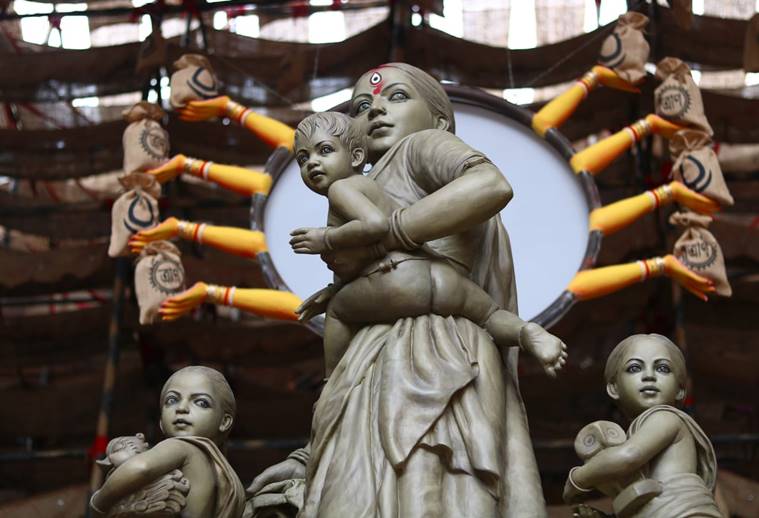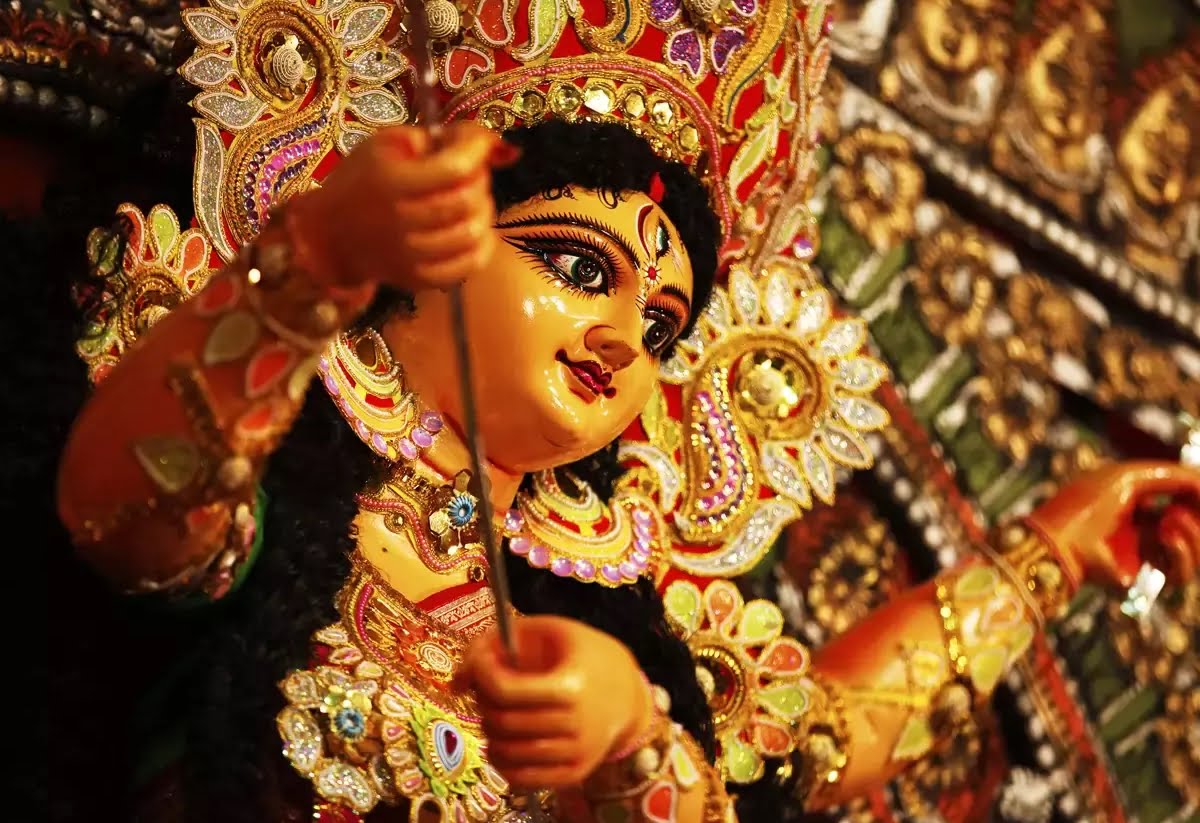Posted by Pratyusha Pramanik
Much before the mainstream Durga Puja celebrations in Bengal began, it was during the Gupta period that the state came under the influence of Vedic-Aryan culture. It is then that the process of integrating the non-Vedic gods and goddesses in Puranic tales began. The non-Vedic goddess resembling Durga was a fearless virgin, hunting and living in mountains and caves, befriending ghosts and wild beasts, dressed in peacock feathers, drinking alcohol, eating meat, and slaying demons. She gradually was given a sanskritised makeover, and was made into a goddess who was endowed with several weapons, battled with and killed demons, especially Mahisasura, and protected her worshippers.
Over time, a non-Vedic Durga was gradually domesticated to suit the puranic tradition and was made an icon of Hindu tradition and pomp. She was further tamed down by worshipping her with her four children–Lakshmi, Saraswati, Ganesha and Karthik.
Her worship started epitomising her benevolence and devotees sought her protection. It is only over time that a non-Vedic goddess was gradually domesticated to suit the puranic tradition and was made an icon of Hindu tradition and pomp. She was further tamed down by worshipping her with her four children–Lakshmi, Saraswati, Ganesha and Karthik. The worship of the warrior goddess, Durga with her family, is unique to Bengal. Experts have traced this to the sixteenth-century ballad Chandimangal. However, there are several texts which refute the claim of domestic bliss for the warrior Goddess.
Also read: Durga, Gender and Sexuality – A Photo Essay
In Chandimangal, Durga becomes the goddess of food and plentitude, she becomes the goddess Annapurna from Parvati. So, material prosperity and bounteous motherhood became a reason for Durga’s popularity, especially in colonial Bengal, which was often stricken with poverty, hunger and famines. Interestingly though, Durga is also considered as the daughter who returns home, from her in-laws after a gap of a year.
The agamani and vijaya songs are poignant lyrics from the shakti tradition but have vaishnav influence. These songs portray vividly the emotions of women as mothers and daughters: The theme of the daughter coming back home to be pampered and adored by her parents continues to be an essential aspect of Durga Puja in Bengal. So the goddess is both the caregiver mother and the beloved daughter.
Experts have also noticed how the family is a representation of a balanced ecosystem with more than one consumer relationship. Furthermore, the worship of the tree-bride as Nabapatrika goes back to the time when idol worship was not prevalent, and farmers prayed for a bountiful harvest. Thus, the present-day Durga Puja in Bengal has had a rich history which has been influenced by various socio-cultural and political changes.
While there was a time when Durga used to be worshipped in various households, gradually it was worshipped only in the households of Rajas and Banias. While Raja Krishnachandra of Krishnanagar is attributed with the feat of first worshipping Durga with her family, it was rich banias like Nabakrishna of Shobhabazaar who added the pomp and zeal in the celebration. The different sections of the society were assigned different responsibilities in the worship, and still, now Durga Puja continues to be a cultural industry which fuels the economy in Bengal. Thus, in the true sense of the term, the goddess bears the responsibility of the nourishment and well being of all her children. Vidyanidhi had observed in Puja Parban–
“The potter brought the clay utensils. The Domni provided various hampers and baskets. The Harini would weave palmyra mats… The teli would provide the oil and the fisherman the fish. Once the fish was brought in the Bagdi woman would gut and scale them with great care. The carpenter from a neighbouring village would craft the idol and the gardener adorned it. The village shoe-maker would be the official drummer while a dorn from another village played the sanai… the dule’s wife would clean and mop the place of worship and the charal’s wife brought in a daily supply of fruits and flowers for the devis offering… the village ironmonger would perform the ritual sacrifice.”
Not only are Muslims, Christians and people from other backgrounds invited, they are also active participants and arrange pujas–To name a few, Md. Ali Park, Park Circus, Ripon Street and Wellesley Street are known for their multi-ethnic pujas. While there is an active effort to portray the festival as an initiative by all and for all, there are various segregations.
The barwari pujas which are arranged by communities is said to have started when few babus were denied entry in one of the elite family Pujas. In the community barwari pujas, it was not essentially the caste which mattered, but anyone who could organise and raise the money for it could be part of it. However, there have been instances when there were fights over not paying the puja subscriptions.
Caste remains a very ambivalent issue in this festival in Bengal. While no one is prevented from participation in the festival, there is a clear demarcation and segregation in the lines of caste and class. All people in the village may have been invited in the celebration, but no one expects them to sit together during the feast. There were carpets for Brahmins and jute mats of varying qualities for members of the other castes.
Similarly, it is mostly the members of the upper caste with the privilege of a well-to-do job that are able to pay higher puja subscription and have greater access to the puja. This becomes even more problematic with the pandemic situation as the Kolkata High Court limits the number of people in the pandal: Chances are that the accessibility will be limited to only the prominent sponsors. Active efforts are being made by the organising committees to make the experience seemingly more inclusive, but the reality is far from satisfactory.
We also need to keep in mind, that a cultural industry which sustains the livelihood of several sections of the society has been visibly affected by the pandemic. The committees have either tried to scale down the pujas because of cost-cutting or to adopt safety measures; this has significantly impacted the informal industry. In a situation like this, we are left wondering what could have best suited the need of the community.
However, such crises are not new to the history of Bengali’s famous festival. Durga Puja has not only been a canvas of the Bengali protest movement during the colonial period, when several pujas were at receiving end of the British ire, for harbouring the Swadeshi fighters. There are also legends how Krishnachandra had to worship Jagadhatri, another form of Durga, later in the year, because he was imprisoned during Durga Puja, and that is how the Jagadhatri Puja began in Krishnanagar.
Similarly, it is also believed that one of the reasons why Durga Puja is celebrated in autumn, instead of the usual spring, calling it the okal bodhon (untimely worship), is because a lot of people used to suffer from chicken pox in the spring time. So such unprecedented situations had made it necessary to bring improvisations.

While the themes of the pujas are a brilliant reflection of the ongoing crises, like the Coronasur and Migrant Mother as the Durga, we feel a general apathy to rise above the occasion and adopt path-breaking measures. This reminds of how in 2016, a puja committee in Salt Lake, West Bengal decided to invite members of the Asur community of Sakhuapani village in Jharkhand. The Asurs had accepted the invitation and decided to be part of the puja. They intended to spread awareness about their community, which have been dehumanised in public imagination. The organisers claimed how Durga did not kill Mahisasur and instead, some other woman did so. They, thereby, tried to create an ambivalence in the identity politics by trying to adhere to the existing social equilibrium of not disturbing the culture of Durga Puja, while simultaneously also acknowledging the presence of the Asur community and their religious beliefs by exhibiting them.
With the rise of caste and class consciousness, Mahisasur is gradually replaced by other social evils. But these attempts by organisers seem half-hearted and without a real understanding of identity politics. It is with similar half-heartedness that the current crisis is being approached.
Also read: Revisiting Ramayana And Its Relevance Through A Feminist Lens
The current government decided to encourage the celebration of Durga Puja to gain an advantage in the upcoming Assembly election. Although helpful for the informal industry, the state now faces the impending crisis of a second wave of the Corona virus. This was the government’s way of playing it safe fearing communal backlash and triggering anti-Hindu sentiments.
With the forthcoming assembly elections in West Bengal, the administration decided to replace an inclusive and safer approach towards the Durga Puja arrangements with appeasement measures. However, the organisers could have been prudent in their decision, especially when Bengal is still recovering from the damage of the cyclone Amphan. The glory of the festival would not have been any less had the massive budget of the mega-clubs been rationed to villages adversely affected by Amphan and the migrant crisis.
The organisers could have been prudent in their decision on Durga Puja arrangements, especially when Bengal is still recovering from the damage of the cyclone Amphan. The glory of the festival would not have been any less had the massive budget of the mega-clubs been rationed to villages adversely affected by Amphan and the migrant crisis.
The fact that these crises have received artistic attention and not enough attention from the organisers of Durga Puja, shows the kind of tokenism practised in Bengal, in how ideas such as identity politics and gender equality might find its way in Bengali films, Puja themes and academia but still struggle to find real-life redressal.
This brings me back to the history of the worship of Devi Durga. Public amnesia has erased the non-Vedic origin of these goddesses and has successfully integrated them in the Brahminic culture.
We should not, however, forget, that Raja Kansanarayan, one of the first Rajas to have initiated the Puja in Bengal, organised it for his repentance of bringing the downfall of Nawabs in Bengal by colluding with the Mughals. This led to the end of the independence of Bengal in 1580, as it came under the Mughal Rule.
The current socio-cultural situation thus, demands a thorough understanding of the impending threat of a second wave of COVID-19 and the ongoing crises; else they might have to invoke some other goddess to repent their historical errors.
Featured Image Source: Economic Times
About the author(s)
Pratyusha Pramanik is a Research Scholar and Teaching Assistant in IIT(BHU) Varanasi. She is interested in Post Colonial Resistance and Protest Movements, Gender and Film Studies. She loves momos, coffee and binge-watching K-Dramas. If not gender sensitising her students, she is busy planning her next solo trip. She will someday own a cafe or a sunflower field.




